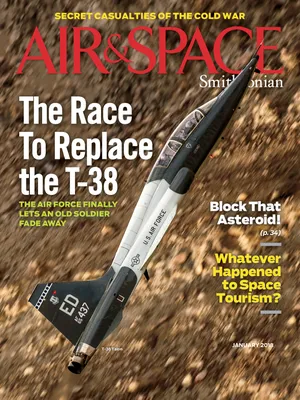Willy Ley, Prophet of the Space Age
How a German immigrant’s excitement about space exploration inspired a generation.
/https://tf-cmsv2-smithsonianmag-media.s3.amazonaws.com/filer/e8/c4/e8c432e3-7f16-479a-bfe1-f35e2adb57dc/willy_ley.jpg)
In his new book, Willy Ley: Prophet of the Space Age, Jared Buss uncovers the life of Willy Ley, an amateur rocketeer who in 1935 fled Nazi Germany for England, eventually settling in the United States, where he became a successful science writer and popularizer of the U.S. space program. Buss spoke with senior associate editor Diane Tedeschi in October.
Air & Space: Why did you decide to write this book?
Jared Buss: When I began researching the history of spaceflight, Ley’s name often surfaced in either a direct or indirect way. He was often credited as a guiding force during the early days of rocketry in Weimar Germany. He was also credited as an influential writer who inspired millions to dream, hope, and believe in a future of interplanetary travel. I began to wonder why so many books focused on the heroic astronauts and engineers of the Space Age, yet so few books focused on the person who peddled the dream and ambitions. This book evolved naturally out of that curiosity about an individual who did so much behind the scenes. I grew convinced that it is impossible to fully understand the complexities of an era without considering the role and contributions of a publicist and writer.
Why do you think Willy Ley has been so overlooked by space historians?
It was understandable that many space historians would focus on heroes and influential figures who became well-known celebrities and public figures. My book does not seek to diminish their contributions and legacies. Yet, I also portray Ley as the “man behind the curtain” of the Space Age. As a publicist, advocate, and writer, he spent much of his life fostering public support for ambitious projects and big dreams. More than many other individuals, he pulled the strings, so to speak, to bolster enthusiasm and confidence in a coming age of rockets and spaceflight. Whether as a writer of influential books on rockets or as a consultant to television shows and toy brands, Ley inspired millions of Americans to believe in a future of space travel.
What are one or two of Ley’s biggest contributions?
Ley’s best-selling Rockets, Missiles, and Space Travel became a very influential best-seller, which educated readers about the history and future potential of rocket technology. His 1949 book The Conquest of Space also became an international sensation, due to both his informative words and the stunning illustrations of Hollywood artist Chesley Bonestell. These two books were widely read by aspiring engineers, science fiction writers, and children in bed with flashlights. They helped engineer the Space Age in popular culture long before the creation of NASA.
Do you think Carl Sagan might have been influenced by Ley?
I have not seen any mention of Ley in existing biographies of Carl Sagan, but I can imagine Sagan being heavily influenced by Ley’s romanticism, faith in science, and general quest to know the cosmos. The similarities between Sagan and Ley are remarkable, both in terms of their general outlooks and their careers as writers of popular science who inspired millions of people. I would not be surprised if Ley’s works occupied a special place on the bookshelf of Sagan during his teenage years. I would also not be surprised if the ranks of NASA included many people who were initially inspired by Ley’s books and articles.

Did Ley have a friendship with Wernher von Braun? Did the two men ever work together?
My biography of Ley charts a very complex relationship with von Braun. Initially, Ley introduced von Braun to circles of Weimar engineers and scientists, although they did not become close friends and companions. In the postwar era, they became friendly colleagues who worked together on many projects, from Disney’s “Man in Space” TV series to popular books. Yet, the two men also remained distant, as von Braun became an insider while Ley served an outsider, working as a writer and publicist. They shared the stage in very influential ways for different reasons.
Does today’s space industry need another Willy Ley to help stimulate interest in planetary exploration?
When Ley died several weeks prior to the lunar landing [in 1969], an obituary predicted dire consequences for NASA if a similar spokesperson and publicist did not come forth. For the cause of spaceflight to ensue, the public would need a similarly committed spokesperson, capable of inspiring confidence and optimism about a future of interplanetary travel. Many notable individuals continued to write popular books while becoming scientific celebrities. Yet in some ways, the world of the popular science writer is a thing of the past. It is difficult to imagine a book today having the same influence as a work by Ley or Sagan. The need for a science writer is still ever present, but the media landscape has changed. My book invites readers to ask, “What was lost?”
